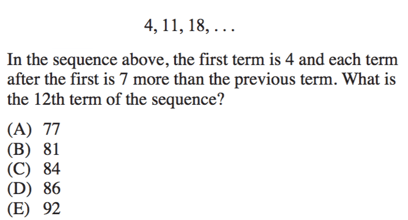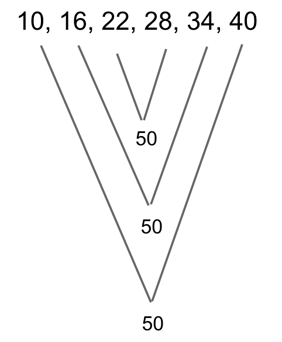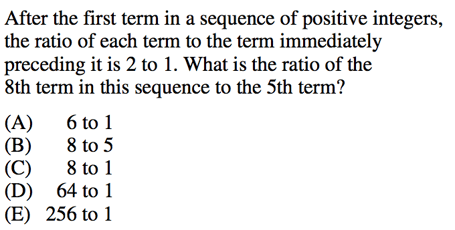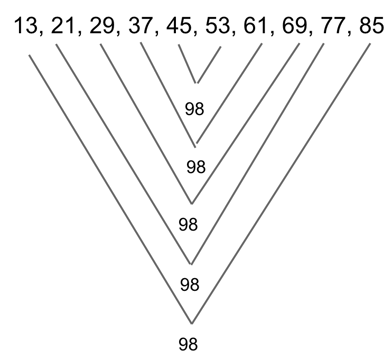
A series of numbers that follows a particular pattern is called a sequence. Sometimes, each new term is found by adding or subtracting a certain constant, sometimes by multiplying or dividing. So long as the pattern is the same for every new term, the numbers are said to lie in a sequence.
Sequence questions will have multiple moving parts and pieces, and you will always have several different options to choose from in order to solve the problem. We’ll walk through all the methods for solving sequence questions, as well as the pros and cons for each. You will likely see two sequence questions on any given SAT, so keep this in mind as you find your perfect balance between time strategies and memorization.
This will be your complete guide to SAT sequence problems--the types of sequences you’ll see, the typical sequence questions that appear on the SAT, and the best ways to solve these types of problems for your particular SAT test taking strategies.
What Are Sequences?
You will see two different types of sequences on the SAT--arithmetic and geometric.
An arithmetic sequence is a sequence wherein each successive term is found by adding or subtracting a constant value. The difference between each term--found by subtracting any two pairs of neighboring terms--is called $d$, the common difference.
14, 11, 8, 5… is an arithmetic sequence with a common difference of -3. We can find the $d$ by subtracting any two pairs of numbers in the sequence, so long as the numbers are next to one another.
$11 - 14 = -3$
$8 - 11 = -3$
$5 - 8 = -3$
14, 17, 20, 23... is an arithmetic sequence in which the common difference is +3. We can find this $d$ by again subtracting pairs of numbers in the sequence.
$17 - 14 = 3$
$20 - 17 = 3$
$23 - 20 = 3$
A geometric sequence is a sequence of numbers in which each new term is found by multiplying or dividing the previous term by a constant value. The difference between each term--found by dividing any neighboring pair of terms--is called $r$, the common ratio.
64, 16, 4, 1, … is a geometric sequence in which the common ratio is $1/4$. We can find the $r$ by dividing any pair of numbers in the sequence, so long as they are next to one another.
$16/64 = 1/4$
$4/16 = 1/4$
$1/4 = 1/4$

Ready...set...let's talk sequence formulas!
Sequence Formulas
Luckily for us, sequences are entirely regular. This means that we can use formulas to find any piece of them we choose, such as the first term, the nth term, or the sum of all our terms.
Do keep in mind, though, that there are pros and cons for memorizing formulas.
Pros--formulas provide you with a quick way to find your answers. You do not have to write out the full sequence by hand or spend your limited test-taking time tallying your numbers (and potentially entering them wrong into your calculator).
Cons--it can be easy to remember a formula incorrectly, which would be worse than not having a formula at all. It also is an expense of brainpower to memorize formulas.
If you are someone who prefers to work with formulas, definitely go ahead and learn them! But if you despise using formulas or worry that you will not remember them accurately, then you are still in luck. Most SAT sequence problems can be solved longhand if you have the time to spare, so you will not have to concern yourself with memorizing your formulas.
That all being said, it’s important to understand why the formulas work, even if you do not plan to memorize them. So let’s take a look.
Arithmetic Sequence Formulas
$$a_n = a_1 + (n - 1)d$$
$$\Sum \terms = (n/2)(a_1 + a_n)$$
These are our two important arithmetic sequence formulas. We’ll look at them one at a time to see why they work and when to use them on the test.
Terms Formula
$a_n = a_1 + (n - 1)d$
This formula allows you to find any individual piece of your arithmetic sequence--the 1st term, the nth term, or the common difference. First, we’ll look at why it works and then look at some problems in action.
$a_1$ is the first term in our sequence. Though the sequence can go on infinitely, we will always have a starting point at our first term. (Note: you can also assign any term to be your first term if you need to. We’ll look at how and why we can do this in one of our examples.)
$a_n$ represents any missing term we want to isolate. For instance, this could be the 4th term, the 58th, or the 202nd.
So why does this formula work?
Imagine that we wanted to find the 2nd term in a sequence. Well each new term is found by adding the common difference, or $d$. This means that the second term would be:
$a_2 = a_1 + d$
And we would then find the 3rd term in the sequence by adding another $d$ to our existing $a_2$. So our 3rd term would be:
$a_3 = (a_1 + d) + d$
Or, in other words:
$a_3 = a_1 + 2d$
If we keep going, the 4th term of the sequence--found by adding another $d$ to our existing third term--would continue this pattern:
$a_4 = (a_1 + 2d) + d$
$a_4 = a_1 + 3d$
We can see that each term in the sequence is found by adding the first term, $a_1$, to a $d$ that is multiplied by $n - 1$. (The 3rd term is $2d$, the 4th term is $3d$, etc.)
So now that we know why the formula works, let’s look at it in action.

Now, there are two ways to solve this problem--using the formula, or simply counting. Let’s look at both methods.
Method 1--arithmetic sequence formula
If we use our formula for arithmetic sequences, we can find our $a_n$ (in this case $a_12$). So let us simply plug in our numbers for $a_1$ and $d$.
$a_n = a_1 + (n - 1)d$
$a_12 = 4 + (12 - 1)7$
$a_12 = 4 + (11)7$
$a_12 = 4 + 77$
$a_12 = 81$
Our final answer is B, 81.
Method 2--counting
Because the difference between each term is regular, we can find that difference by simply adding our $d$ to each successive term until we reach our 12th term.
Of course, this method will take a little more time than simply using the formula, and it is easy to lose track of your place. The test makers know this and will provide answers that are one or two places off, so make sure to keep your work organized so that you do not fall for bait answers.
First, line up your twelve terms and then fill in the blanks by adding 7 to each new term.
4, 11, 18, ___, ___, ___, ___, ___, ___, ___, ___, ___
4, 11, 18, 25, ___, ___, ___, ___, ___, ___, ___, ___
4, 11, 18, 25, 32, ___, ___, ___, ___, ___, ___, ___
And so on, until you get:
4, 11, 18, 25, 32, 39, 46, 53, 60, 67, 74, 81
Again, the 12th term is B, 81.
Sum Formula
$\Sum \terms = (n/2)(a_1 + a_n)$
Our second arithmetic sequence formula tells us the sum of a set of our terms in a sequence, from the first term ($a_1$) to the nth term ($a_n$).
Basically, we do this by multiplying the number of terms, $n$, by the average of the first term and the nth term.
Why does this formula work?
Well let’s look at an arithmetic sequence in action:
10, 16, 22, 28, 34, 40
This is an arithmetic sequence with a common difference, $d$, of 6.
A neat trick you can do with any arithmetic sequence is to take the sum of the pairs of terms, starting from the outsides in. Each pair will have the same exact sum.

So you can see that the sum of the sequence is $50 * 3 = 150$.
In other words, we are taking the sum of our first term and our nth term (in this case, 40 is our 6th term) and multiplying it by half of $n$ (in this case $6/2 = 3$).
Another way to think of it is to take the average of our first and nth terms--${10 + 40}/2 = 25$ and then multiply that value by the number of terms in the sequence--$25 * 6 = 150$.
Either way, you are using the same basic formula. How you like to think of the equation and whether or not you prefer $(n/2)(a_1 + a_n)$ or $n({a_1 + a_n}/2)$, is completely up to you.
Now let’s look at the formula in action.
Kyle started a new job as a telemarketer and, every day, he is supposed to make 3 more phone calls than the day previous. If he made 10 phone calls his first day, and he meets his goal, how many total phone calls does he make in his first two weeks, if he works every single day?
-
413
-
416
-
426
-
429
-
489
As with almost all sequence questions on the SAT, we have the choice to use our formulas or do the problem longhand. Let’s try both ways.
Method 1--formulas
We know that our formula for arithmetic sequence sums is:
$\Sum = (n/2)(a_1 + a_n)$
But, we must first find the value of our $a_n$ in order to use this formula. Once again, we can do this via our first arithmetic sequence formula, or we can find it by hand. As we are already using formulas, let us use our first formula.
$a_n = a_1 + (n - 1)d$
We are told that Kyle makes 10 phone calls on his first day, so our $a_1$ is 10. We also know that he makes 3 more calls every day, for a total of 2 full weeks (14 days), which means our $d$ is 3 and our $n$ is 14. We have all our pieces to complete this first formula.
$a_n = a_1 + (n - 1)d$
$a_14 = 10 + (14 - 1)3$
$a_14 = 10 + (13)3$
$a_14 = 10 + 39$
$a_14 = 49$
And now that we have our value for $a_n$ (in this case $a_14$), we can complete our sum formula.
$(n/2)(a_1 + a_n)$
$(14/2)(10 + 49)$
$7(59)$
$413$
Our final answer is A, 413.
Method 2--longhand
Alternatively, we can solve this problem by doing it longhand. It will take a little longer, but this way also carries less risk of incorrectly remember our formulas. As always, how you choose to solve these problems is completely up to you.
First, let us write out our sequence, beginning with 10 and adding 3 to each subsequence number, until we find our nth (14th) term.
10, 13, 16, 19, 22, 25, 28, 31, 34, 37, 40, 43, 46, 49
Now, we can either add them up all by hand--$10 + 13 + 16 + 19 + 22 + 25 + 28 + 31 + 34 + 37 + 40 + 43 + 46 + 49 = 413$
Or we can use our arithmetic sequence sum trick and divide the sequence into pairs.

We can see that there are 7 pairs of 59, so $7 * 59 = 413$.
Again, our final answer is A, 413.
 Only one more formula to go. Almost there!
Only one more formula to go. Almost there!
Geometric Sequence Formulas
$$a_n = a_1( r^{n - 1})$$
(Note: while there is a formula to find the sum of a geometric sequence, but you will never be asked to find this on the SAT, and so it is not included in this guide.)
As with the first arithmetic sequence formula, this formula will allow you to find any number of missing pieces, including your 1st term, your nth term, or your $r$.
And, as always with sequences, you have the choice of whether to solve your problem longhand or with a formula.

Method 1--formula
If you’re one for memorizing formulas, we can simply plug in our values into our equation in place of $a_n$, $n$, and $r$ in order to solve for $a_1$.
We are told that Mr. Smith has 1 dollar 5 days later, which would be the 6th day (meaning our $n$ is 6), and that the ratio between each term is $1/4$.
$a_n = a_1( r^{n - 1})$
$1 = a_1({1/4}^{6 - 1})$
$1 = a_1({1/4}^5)$
$1 = a_1(0.00097656)$
$1/0.00097656 = a_1$
$1024 = a_1$
So the 1st term in the sequence is 1024, which means that Mr. Smith starts with $1024 on Monday morning.
Our final answer is 1024.
Method 2--longhand
Alternatively, we can, as always, solve them problem by hand.
First, set out our number of terms in order to keep track of them, with our 7th term, $1, last.
___, ___, ___, ___, ___, 1
Now, because our ratio is $1/4$ and we are working backwards, we must multiply each term by 4. (Why? Because ${1/{(1/4)} = 1 * 4$, according to the rules of fractions).
___, ___, ___, ___, 4, 1
___, ___, ___, 16, 4, 1
And, if we keep going, we will eventually get:
1024, 256, 64, 16, 4, 1
Which means that we can see that our 1st term is 1024.
Again, our final answer is 1024.
As with all sequence solving methods, there are benefits and drawbacks to solving the question in each way. If you choose to use formulas, make very sure you can remember them exactly.
And if you solve the questions by hand, be very careful to find the exact number of terms in the sequence. It can be all too easy to accidentally find one term more or fewer if you’re not carefully labeling or otherwise keeping track of your terms.

I'm preeeeetty sure it's not a proper math formula unless mystery variables and exploding test tubes are involved somehow.
Typical SAT Sequences Questions
Because all sequence questions on the SAT can be solved without the use or knowledge of sequence formulas, the test-makers will only ever ask you for a limited number of terms or the sum of a small number of terms (usually 12 or fewer).
As we saw above, you may be asked to find the 1st term in a sequence, the nth term, the difference between your terms (whether a common difference, $d$, or a common ratio, $r$), or the sum of your terms (in arithmetic sequences only).
You also may be asked to find an unusual twist on a sequence question that combines your knowledge of sequences or your knowledge of sequences and other SAT math topics.
For example:

Again, let us look at both formulaic and longhand methods for how to solve a problem like this.
Method 1--formulas
We are told that the ratio between the terms in our sequence is 2:1, successive term to previous term. This means that our common ratio is 2, as each term is being multiplied by 2 in order to find the next term. (Note: if you are not familiar with ratios, check out our guide to SAT ratios.)
Now, we can find the ratio between our 8th and 5th terms in a few different ways, but the simplest way--while still using formulas--is simply to reassign our 5th term as our 1st term instead. This would then make our 8th term become our 4th term.
(Why the 4th term? The 5th and 8th terms are 3 spaces from each other--5th to 6th, 6th to 7th, and 7th to 8th--which means our 1st term must be 3 spaces from our new nth term--1st to 2nd, 2nd to 3rd, 3rd to 4th).
Once we’ve designated our 5th term as our 1st term, we can use the strategy of plugging in numbers and assign a random value for our $a_1$. Then we will plug in our known values of $r$ (2) and $n$ (3) so that we can find our $a_n$.
Let us call $a_1$ 4. (Why 4? Why not!)
$a_n = a_1( r^{n - 1})$
$a_4 = 4(2^{4 - 1})$
$a_4 = 4(2^3)$
$a_4 = 4(8)$
$a_4 = 32$
So the ratio between our 4th term and our 1st term (the equivalent of the ratio to our 8th term and our 5th term) is:
$32:4$
Or, when we reduce:
$8:1$
The ratio between our 8th term and our 5th term is $8:1$
Our final answer is C, $8:1$.
As you can see, this problem was tricky because we had to reassign our terms and use our own numbers before we even considered having to use our formulas. Let us look at this problem were we to solve it longhand instead.
Method 2--longhand
If we choose to solve this problem longhand, we will not have to concern ourselves with reassigning our terms, but we will still have to understand that there are 3 spaces between our 8th and our 5th terms (8th to 7th, 7th to 6th, and 6th to 5th).
Since we used the technique of plugging in our own numbers last time, let us use algebra for our longhand method.
We know that each term is found by doubling the previous term. So let us say that our 5th term is $x$.
___, ___, ___, ___, x, ___, ___, ___
This would make our 6th term $2x$.
___, ___, ___, ___, x, 2x, ___, ___
And we can continue down the line until we get:
___, ___, ___, ___, x, 2x, 4x, 8x
This means that our ratio between our 8th term and our 5th term is:
$8x:x$
Or, in other words:
$8:1$
Our final answer is, again, C, $8:1$.
Again, you always have the choice to use formulas or longhand to solve these questions and how you prioritize your time (and/or how careful you are with your calculations) will ultimately decide which method you use.
 Now let's take a look at our SAT sequence question strategies.
Now let's take a look at our SAT sequence question strategies.
Tips For Solving Sequence Questions
Sequence questions can be somewhat tricky and arduous to work through, so keep in mind these SAT math tips on sequences as you go through your studies:
1) Decide before test day whether or not you will use the sequence formulas
Before you go through the effort of committing your formulas to memory, think about the kind of test-taker you are. If you are someone who loves to use formulas, then go ahead and memorize them now. Most sequence questions will go much faster once you have gotten used to using your formula.
However, if you would rather dedicate your time and brainpower to other math topics or if you would simply rather solve sequence questions longhand, then don’t worry about your formulas! Don’t even bother to try to remember them--just decide here and now not to use them and save your mental energy for other pursuits.
Unless you can be sure to remember them correctly, formulas will hinder more than help you on test day. So make the decision now to either memorize your formulas or forget about them entirely.
2) Write your values down and keep your work organized
Though many calculators can perform long strings of calculations, sequence questions by definition involve many different values and terms. Small errors in your work can cause a cascade effect and one mistyped digit in your calculator can throw off your work completely. Even worse, you won’t know where the error happened if you do not keep track of your values.
Always write down your values and label your terms in order to prevent a misstep somewhere down the line.
3) Keep careful track of your timing
No matter how you solve a sequence question, these types of problems will generally take you more time than other math questions on the SAT. For this reason, most sequence questions are located in the last third of any particular SAT math section, which means the test-makers think of sequences as a “high difficulty” level problem.
Time is your most valuable asset on the SAT, so always make sure you are using yours wisely. If you feel you can (accurately) answer two other math questions in the time it takes you to answer one sequence question, then maximize your point gain by focusing on the other two questions.
Always remember that each question on the SAT math section is worth the same amount of points and you will get dinged if you get a question wrong. Prioritize both your quantity of answered questions as well as your accuracy, and don’t let your time run out trying to solve one problem.
If you feel that you can answer a sequence problem quickly, go ahead! But if you feel it will take up too much time, move on and come back to it later (or skip it entirely, if you need to).
 No matter which method you choose to use, trust that you'll find the one that best suits your needs and abilities.
No matter which method you choose to use, trust that you'll find the one that best suits your needs and abilities.
Test Your Knowledge
Now let’s test your sequence knowledge with real SAT math problems.
1)

2) What is the sum of the first 10 terms in the arithmetic sequence that begins: 13, 21, 29,...
-
450
-
458
-
474
-
482
-
490
3)

Answers: 200, E, 2035
Answer Explanations:
1) The number of squirrels triples every three years, so this is a geometric sequence. As always, we can either count longhand or use our formulas. Let’s look at each way.
We first need to count how many times three years has passed between 1990 and 1999.
Including the year 1990 and the year 1999, there are 4 terms for every 3 years between 1990 and 1999.
1990, 1993, 1996, 1999
This means that 1999 is our 4th term and 1990 is our 1st term. Now let’s plug in our values into our formula.
$a_n = a_1( r^{n - 1})$
$5400 = a_1(3^{4-1})$
$5400 = a_1(3^3)$
$5400 = a_1(27)$
$200 = a_1$
Our first term is 200.
There were 200 squirrels in 1990.
Alternatively, we can simply find the number of squirrels in 1990 by counting by hand.
Again, we need to find the number of groups of 3 years between 1990 and 1999, inclusive.
1990, 1993, 1996, 1999
Now, let us plug in our known value for 1999 and find the rest of our terms by dividing each term by 3.
___, ___, ___, 5400
___, ___, 1800, 5400
And so on, until you get:
200, 600, 1800, 5400
Again, our first term is 200.
There were 200 squirrels in 1990.
2) We are asked to find the sum of this arithmetic sequence, which means we can either use our formula or count our sequence by hand.
Method 1--formulas
First, we need to determine our common difference, $d$, in the sequence. To do so, let us subtract one of our neighboring pairs of numbers.
$21 - 13 = 8$
Before we can find our sum, however, we must find our $a_10$. This means we need to use our first arithmetic sequence formula:
$a_n = a_1 + (n - 1)d$
$a_10 = 13 + (10 - 1)8$
$a_10 = 13 + 72$
$a_10 = 85$
Now that we know our $d$ and our $a_10$, we can plug in our values to find our sum.
$(n/2)(a_1 + a_n)$
$(10/5)(13 + 85)$
$(5)(98)$
$490$
Our final answer is E, 490.
Method 2--counting
If you do not want to remember or use your formulas, you can always find your answer by counting.
First, we must still determine our $d$ by subtracting our neighboring terms:
$29 - 21 = 8$
Now, we can find the value of all our terms by continuing to add 8 to each new term until we reach our 10th term.
13, 21, 29, ___, ___, ___, ___, ___, ___, ___
13, 21, 29, 37, ___, ___, ___, ___, ___, ___
13, 21, 29, 37, 45, ___, ___, ___, ___, ___
And so on, until we finally get:
13, 21, 29, 37, 45, 53, 61, 69, 77, 85
Now, we can either add them up individually ($13 + 21 + 29 + 37 + 45 + 53 + 61 + 69 + 77 + 85 = 490$), or you can, find your pairs of numbers, beginning from the outside in.

We can see that there are 5 pairs of 98, so $5 * 98 = 450$
Our final answer is E, 490.
3) Because the price of our mystery item raises by $2 every year, this is an arithmetic sequence. Again, we have multiple ways to solve this kind of problem--using formulas, or counting longhand.
Method 1--formulas
$a_n = a_1 + (n - 1)d$
$100 = 10 + (n - 1)2$
$100 = 10 + 2n - 2$
$100 = 8 + 2n$
$92 = 2n$
$n = 46$
Now, we know that 100 is the price at our 46th term, but this is not the same thing as 46 years from 1990. Remember: the number of terms from the 1st is always 1 fewer space than the actual count of the term.
For instance, the 1st term in a sequence is 4 spaces from the 5th term and 5 spaces from the 6th term. Why?
1st to 2nd, 2nd to 3rd, 3rd to 4th, 4th to 5th. We can see it takes 4 total spaces to go from the 1st term to the 5th.
For our price problem, our $n$ is 46, which means that the year will be $46 - 1 = 45$ actual spaces away from our starting term.
So:
$1990 + (46 - 1)$
$1990 + 45$
$2035$
The price will be $100 in 2035.
Method 2--counting
Because each new term is determined by adding 2, it will take us a long time to get from 10 to 100. We can speed up this process by first finding the difference between the 1st and last term:
$100 - 10 = 90$
And then we can divide this difference by the common difference, $d$:
$90/2 = 45$
It will take 45 years to get to the price to raise to $100. 45 years after 1990 is:
$1990 + 45$
$2035$
Again, the price will be $100 in 2035.
 Yeah! You toppled those sequence questions!
Yeah! You toppled those sequence questions!
The Take Aways
Though sequence questions can take some little time to work through, they are usually made complicated by their number of terms and values rather than being actually difficult to solve.
So long as you remember to keep all your work organized and decide before test-day whether or not you want to spend your study efforts memorizing, and you’ll be able to tackle any number of sequence questions the SAT can throw your way. As long as you keep your values straight (and don’t get tricked by bait answers!), you will be able to grind through these problems without fail.
What’s Next?
Now that you've taken on sequences and dominated, it's time to make sure you have a solid handle on the rest of your SAT math topics. The SAT presents familiar concepts in unfamiliar ways, so check out our guides on all your individual SAT topic needs. We'll provide you with all the strategies and practice problems on any SAT math topic you could ask for.
Running out of time on SAT math? Not to worry! Our guide will show you how to maximize both your time and your score so that you can make the most of your time on test day.
Don't know what score to aim for? Follow our simple steps to figure out what score is best for you and your needs.
Looking to get a perfect score? Check out our guide to getting a perfect 800 on SAT math, written by a perfect-scorer!
Want to improve your SAT score by 160 points?
Check out our best-in-class online SAT prep program. We guarantee your money back if you don't improve your SAT score by 160 points or more.
Our program is entirely online, and it customizes what you study to your strengths and weaknesses. If you liked this Math strategy guide, you'll love our program. Along with more detailed lessons, you'll get thousands of practice problems organized by individual skills so you learn most effectively. We'll also give you a step-by-step program to follow so you'll never be confused about what to study next.
Check out our 5-day free trial:
Have friends who also need help with test prep? Share this article!

Courtney scored in the 99th percentile on the SAT in high school and went on to graduate from Stanford University with a degree in Cultural and Social Anthropology. She is passionate about bringing education and the tools to succeed to students from all backgrounds and walks of life, as she believes open education is one of the great societal equalizers. She has years of tutoring experience and writes creative works in her free time.


































 Holly R.
Holly R.